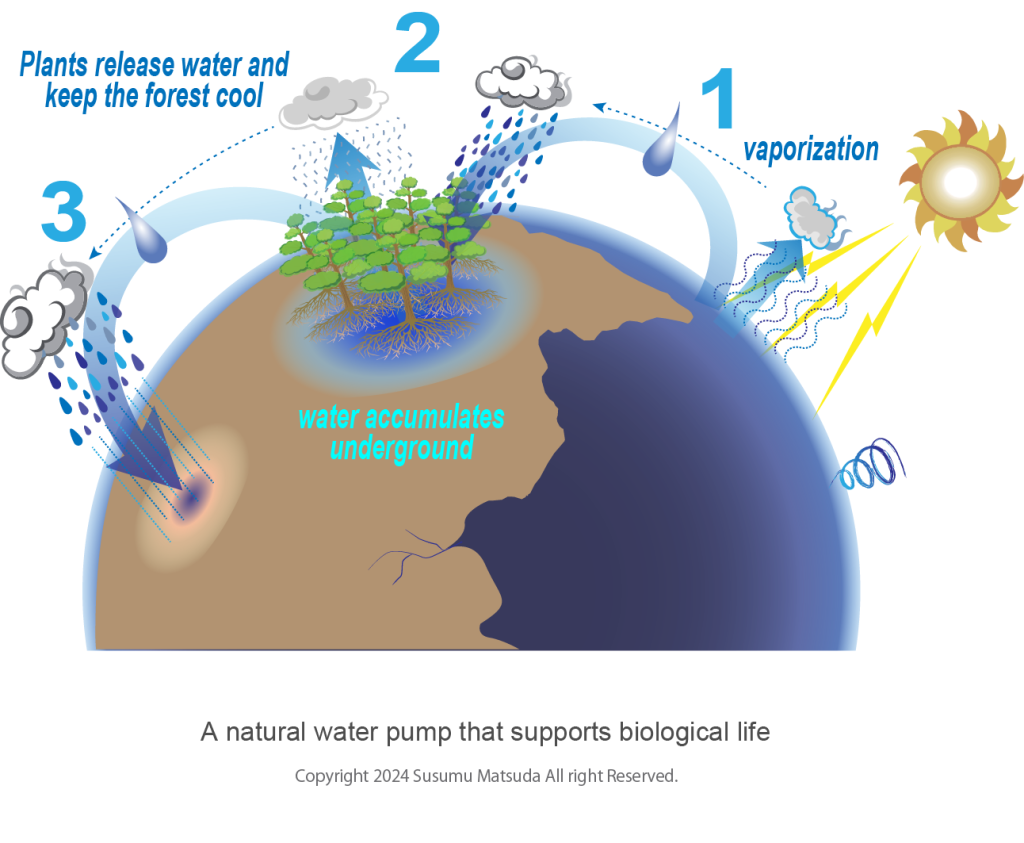In recent years, the rate of natural disasters caused by typhoons and hurricanes has been increasing due to climate change. In order to maintain a safe and secure life for people, I think it is important to study the water cycle, which directly affects the living environment. First, let’s check how the Earth circulates water. Most of the water on Earth is stored in the oceans, and more than 70% of the Earth is covered by the ocean. In addition, the light energy emitted from the sun heats the ocean water with radiant heat and vaporizes it. The vaporized water rises into the sky and forms rain clouds. The rain clouds move through atmospheric circulation and reach land. (1 in the figure) When the rain clouds collide with a high mountain range, they become rain and fall on the ground. Rain that falls in the forest falls on the plants and soil on the ground. On the ground, plants absorb the water and take it into the plants. Leaf mold formed from fallen leaves in the forest stores a certain amount of water. Water that passes through the leaf mold layer seeps into the soil. In this way, forests store a large amount of water. The large amount of water stored in the forest is used by plants to prevent the temperature from rising. The temperature of the forest is kept constant by evaporating the stored water. The evaporated water rises to the sky above the forest and forms rain clouds again. (2 in the figure) The rain clouds are carried by atmospheric winds in the sky to the depths of the land, where they become rain and fall on the ground again. (3 in the figure) In this way, the forest plays a role in transporting water to the depths of the land. Forests also have the ability to store a certain amount of water that falls on the earth, and the evaporation mechanism that regulates the forest’s temperature plays a role in keeping the Earth’s temperature constant.

This mechanism for transporting water is called a natural water pump. If the forest decreases, the natural water pump will not work. This will result in the disappearance of the mechanism for transporting water to the depths of the land. The inability of the natural water pump to work will also lead to the acceleration of desertification. Concreting urban areas changes the route by which water flows. Concreting prevents water from penetrating and accumulating underground in urban areas, and the water flows directly into rivers and then into the sea. In this way, water does not penetrate the soil and groundwater does not accumulate. Additionally, there are few forests in cities, so the soil is unable to temporarily store water. This has been the case in urban areas for a long time, and the area is increasing. In this way, the amount of dry areas on Earth is gradually increasing. As the environment in which people live becomes more convenient, the paths that water flows through are changing significantly. We are required to live our lives with the awareness that the state of the water cycle is constantly changing. We believe that learning about the mechanism of the water cycle will lead to safety and peace of mind.